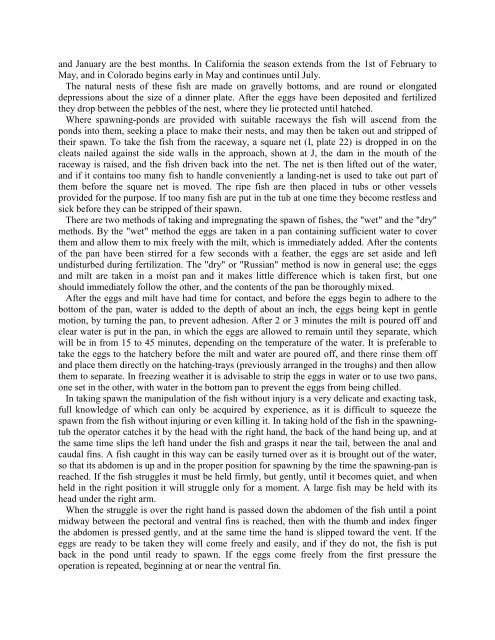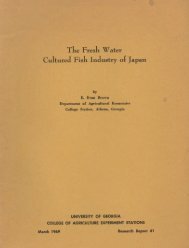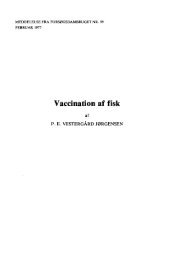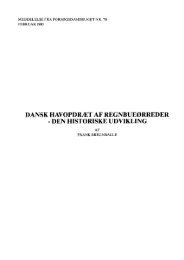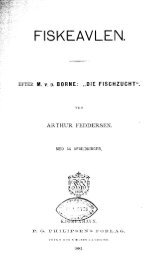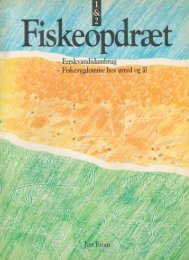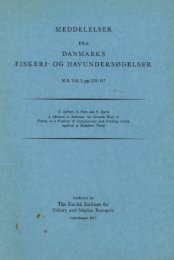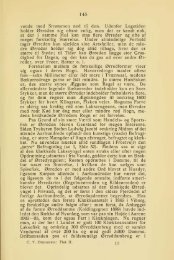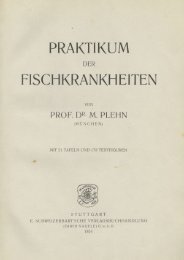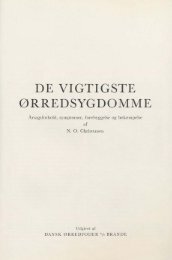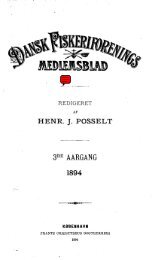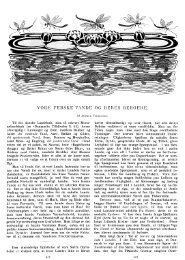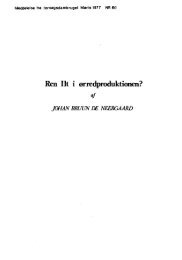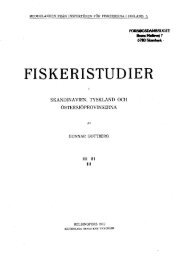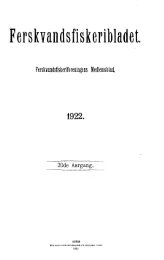You also want an ePaper? Increase the reach of your titles
YUMPU automatically turns print PDFs into web optimized ePapers that Google loves.
and January are the best months. In California the season extends from the 1st of February toMay, and in Colorado begins early in May and continues until July.<strong>The</strong> natural nests of these fish are made on gravelly bottoms, and are round or elongateddepressions about the size of a dinner plate. After the eggs have been deposited and fertilizedthey drop between the pebbles of the nest, where they lie protected until hatched.Where spawning-ponds are provided with suitable raceways the fish will ascend from theponds into them, seeking a place to make their nests, and may then be taken out and stripped oftheir spawn. To take the fish from the raceway, a square net (I, plate 22) is dropped in on thecleats nailed against the side walls in the approach, shown at J, the dam in the mouth of theraceway is raised, and the fish driven back into the net. <strong>The</strong> net is then lifted out of the water,and if it contains too many fish to handle conveniently a landing-net is used to take out part ofthem before the square net is moved. <strong>The</strong> ripe fish are then placed in tubs or other vesselsprovided for the purpose. If too many fish are put in the tub at one time they become restless andsick before they can be stripped of their spawn.<strong>The</strong>re are two methods of taking and impregnating the spawn of fishes, the "wet" and the "dry"methods. By the "wet" method the eggs are taken in a pan containing sufficient water to coverthem and allow them to mix freely with the milt, which is immediately added. After the contentsof the pan have been stirred for a few seconds with a feather, the eggs are set aside and leftundisturbed during fertilization. <strong>The</strong> "dry" or "Russian" method is now in general use; the eggsand milt are taken in a moist pan and it makes little difference which is taken first, but oneshould immediately follow the other, and the contents of the pan be thoroughly mixed.After the eggs and milt have had time for contact, and before the eggs begin to adhere to thebottom of the pan, water is added to the depth of about an inch, the eggs being kept in gentlemotion, by turning the pan, to prevent adhesion. After 2 or 3 minutes the milt is poured off andclear water is put in the pan, in which the eggs are allowed to remain until they separate, whichwill be in from 15 to 45 minutes, depending on the temperature of the water. It is preferable totake the eggs to the hatchery before the milt and water are poured off, and there rinse them offand place them directly on the hatching-trays (previously arranged in the troughs) and then allowthem to separate. In freezing weather it is advisable to strip the eggs in water or to use two pans,one set in the other, with water in the bottom pan to prevent the eggs from being chilled.In taking spawn the manipulation of the fish without injury is a very delicate and exacting task,full knowledge of which can only be acquired by experience, as it is difficult to squeeze thespawn from the fish without injuring or even killing it. In taking hold of the fish in the spawningtubthe operator catches it by the head with the right hand, the back of the hand being up, and atthe same time slips the left hand under the fish and grasps it near the tail, between the anal andcaudal fins. A fish caught in this way can be easily turned over as it is brought out of the water,so that its abdomen is up and in the proper position for spawning by the time the spawning-pan isreached. If the fish struggles it must be held firmly, but gently, until it becomes quiet, and whenheld in the right position it will struggle only for a moment. A large fish may be held with itshead under the right arm.When the struggle is over the right hand is passed down the abdomen of the fish until a pointmidway between the pectoral and ventral fins is reached, then with the thumb and index fingerthe abdomen is pressed gently, and at the same time the hand is slipped toward the vent. If theeggs are ready to be taken they will come freely and easily, and if they do not, the fish is putback in the pond until ready to spawn. If the eggs come freely from the first pressure theoperation is repeated, beginning at or near the ventral fin.


